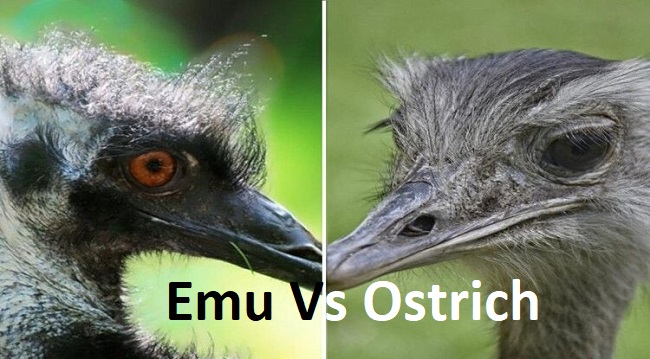Emus and Ostriches, known for their large size and inability to fly, often lead to confusion. While they share certain traits, these two bird species are vastly different. So, what distinguishes an Emu from an Ostrich?
In this article, we delve into the details, comparing the Emu and the Ostrich based on a variety of factors including physical characteristics, behavior, and habitat, to help you distinguish between the two.

Physical Differences: Emu Vs Ostrich
While both birds are large and flightless, several physical differences set them apart.
Size and Weight
The Ostrich, native to Africa, holds the title as the world’s largest bird. An adult Ostrich can reach up to 9 feet in height and weigh between 220 to 350 pounds.
The Emu, Australia’s largest bird, is slightly smaller. Adult Emus typically stand around 6 feet tall and weigh between 90 to 150 pounds.
Feather Characteristics
Ostriches have unique, fluffy feathers that lack the tiny hooks that would hold them together for flight. Emus, on the other hand, have a double-shafted feather structure, giving them a hair-like appearance.
Leg and Foot Structure
Ostriches possess two-toed feet equipped with a large, lethal claw. Emus have three-toed feet but lack the sizable claw of their African counterparts.
Behavioral Differences: Emu Vs Ostrich
Beyond physical traits, Emus and Ostriches also demonstrate significant behavioral differences.
Running Speed
Both birds are famed for their speed. Ostriches are the fastest, capable of reaching speeds up to 60 mph, while Emus can run at impressive speeds of around 30 mph.
Nesting and Parenting
Interestingly, male Emus and Ostriches play a significant role in nesting and parenting. However, the Ostrich’s parenting style is communal, with several females laying eggs in a dominant male’s nest, who then incubates and guards them.
In contrast, the Emu’s approach is more individualistic: a female Emu lays her eggs and then the male takes over, incubating the eggs and caring for the chicks once they hatch.
Habitat and Diet: Emu Vs Ostrich
The habitats of these two bird species vary drastically due to their geographical locations.
Habitat
Ostriches are adapted to the arid plains of Africa, whereas Emus are found across a wide range of habitats in Australia, including forests, grasslands, and even desert areas.
Diet
Both birds are omnivorous, but their diets vary based on their environment. Ostriches primarily feed on seeds, shrubs, grass, fruits, and occasionally small insects. Emus have a broader diet, consuming plants, seeds, fruits, insects, and even small animals.
Conclusion
While they may appear similar at a glance, the Emu and Ostrich are unique species, each adapted to their own distinct environments and lifestyles. They captivate us with their impressive size, peculiar characteristics, and fascinating behaviors.
Although both belong to the flightless bird group, the differences between the Emu and Ostrich demonstrate the beautiful diversity within the avian world.
Whether it’s the Emu’s adaptability to various habitats or the Ostrich’s title as the world’s largest bird, both species hold their own intriguing place in the natural world.
























